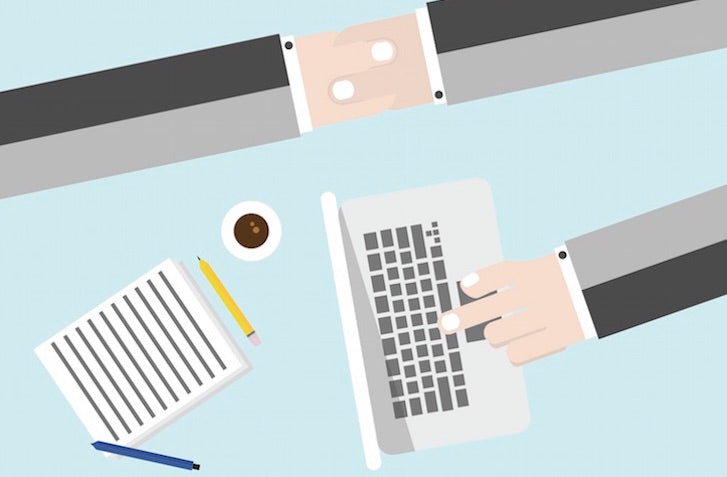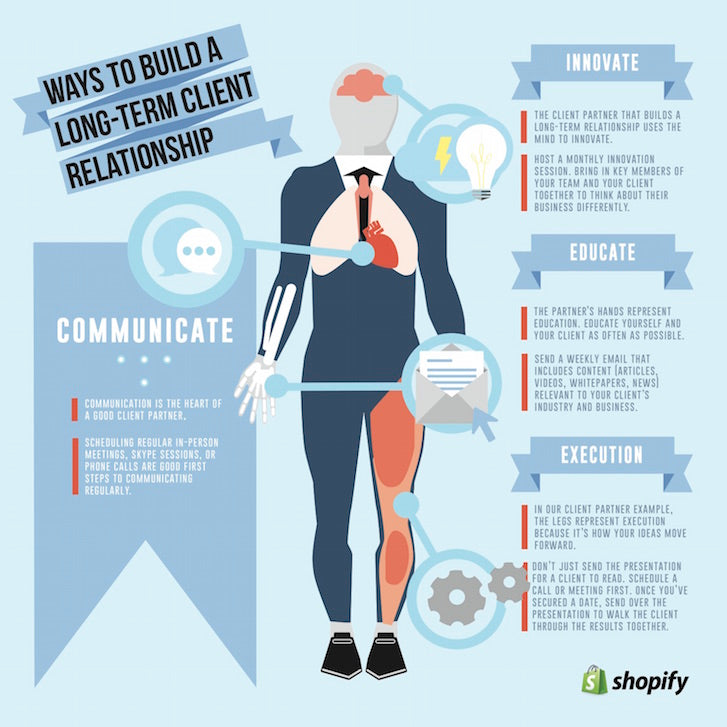Read to the end for an infographic about building long-term client relationships!
If you’ve just finished building a website or custom app with a new client, you’re probably wondering what’s next. How can you turn this opportunity into a successful long-term partnership that will result in continued collaboration with a client?
In my experience, a good long-term client relationship is nurtured by being a collaborative partner rather than a transactional vendor. It’s about building a deep relationship and having an invested interest in my client’s business because of the work I contribute. It’s about constructing a long-term vision rather than hopping from job to job.
So how can you achieve a sustainable long-term client relationship that results in repeat business?
To help visualize the different components of relationship building, I’m going to use the analogy of the human body and some of its vital organs: the heart, the mind, the hands, and the legs.
You might also like: How Building Customer Relationships Will Help You Create a Million Dollar Business
Communicate
Communication is the heart of a good client-partner relationship, and it will be the foundation from which all the other traits in this post branch out. Knowing how and when to communicate with your client will be a crucial element to the relationship you build.
Scheduling regular in-person meetings, Skype sessions, or phone calls are good first steps to communicating regularly. When you’re in campaign or project mode, it’s important to be in frequent contact with your client. Keep in touch and keep your client informed during every step of the campaign. This level of communication keeps your dialogue open and honest, and your client will be aware of your progress, opportunities, challenges, and results to date.
Educate
The partner’s hands represent education. Educate yourself and your client as often as possible. The more you know about the industry and your client’s business, the more you’ll become a valuable resource with the knowledge you share.
Send a weekly email that includes content (articles, videos, white papers, news) that is relevant to your client’s industry and business, events and webinars that your client might want to attend, and speaking opportunities that will help grow company profile.
This attention will show your client that you’re constantly paying attention and thinking about them. You’re also helping them stay on top of their business when they might not have the time.
Continued education is an integral component of my next point, because being informed will allow you and your client to make better decisions.

Innovate
Partners that build a long-term relationship use the mind to innovate. Share new ideas outside of your regular scope of work that will help your client stand out from their competitors. This approach will also help clients that might be resistant to change open up to new ideas, and over time expand their scope of work. This process is meant to be an exercise that will keep your team continually thinking about fresh ideas for your client.
Host a monthly innovation session. Bring key members of your team and your client together to think about their business differently. Focus the discussion around one question that successful entrepreneur Ben Horowitz poses in his book, The Hard Thing About Hard Things: What are we not doing? Have each team member contribute ideas so the conversation isn’t focused on or building from what you’re already doing well for your client.
Why does this work? This process will help find loopholes and anticipate needed areas of business focus that might not have been clear before.
You might also like: 4 Quick Ways to Build Trust With a New Client
Execution
In our client partner example, the legs represent execution because it’s how your ideas move forward.
Filmmaker Casey Neistat swears by the mantra, “Ideas are easy, execution is everything.” Delivering results is the most important component of sustaining long-term client relationships. It proves to your client that you can execute the ideas you’ve put forward, and that you’re providing more than just expensive consulting.
Meet your deadlines and deliver to expectation to cover the basis of good execution. But, if you really want to take your efforts to the next level and make your client value your relationship, then start thinking about execution in two buckets: how you execute and how you deliver the results.
Try the following:
- Write a daily recap email when in full campaign mode that clearly and simply outlines your team efforts of the day, and next steps for tomorrow. If you have a lot of information to share, use subtitles, bolding, and italics to hone in on areas of importance and make the email or report easy to read.
- Pick up the phone to have a quick call with your client and gauge any reactions to daily emails. While email is a good basis to deliver daily results, a follow-up call will help create a discussion, or identify areas the team might need to adapt based on client feedback and expectations.
- Visualize campaign results to amplify your success and opportunity. You want to elevate your team’s efforts and show your client why they invested in your expertise. Use screen shots, diagrams, charts, and images to help visualize your results. Focus on really showing your client what’s happening rather than just telling them.
- Don’t just send the presentation for a client to read. Presentations can be misinterpreted without your context and perspective. Schedule a call or meeting first, and once scheduled, provide a copy of the presentation you’ll be discussing with your client so you can walk through the results together.
These tasks can seem trivial or too common, but you’d be surprised how communication can slip away during the execution phase of a project.
Remember: relationships are meant to be human connections, not a series of transactions. Strong communication will be the core of your developing client partnership, and it will feed the other important components that will have your client turning to you as a trusted partner in their business. None of this will be easy. Securing repeat business with your client is a long road and requires a lot of work. But the rewards will be well deserved — you’ll have a client that values your expertise, and your client will have someone on their team that believes in their business.
To sum it up
Here's an infographic summarizing what I've discussed above. Feel free to share!

Illustrated by Joanna Stecewicz
Read more
- 4 Key Ways to Differentiate Your Clients’ Ecommerce Stores From the Competition
- What You Missed at Generate Conference 2014
- Learn from the Shopify Experts Who Won Build A Business
- 5 Ways to Use Email Marketing to Help Your Subscription-Based Clients
- 7 Ways to Create an Amazing Customer Experience for Your Clients’ Ecommerce Stores
- 4 Conferences You Should Attend
- How to Get Your Clients Up and Running With Shopify POS
- Grow Your Business With This Free Book
- 3 Ways to Use a Phone Number to Boost Your Client’s Business
You might also like: The Power of Community: How Nurturing Your Network Can Propel Your Business

